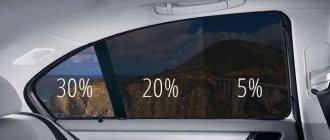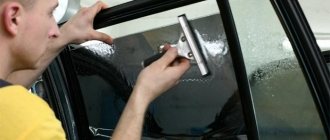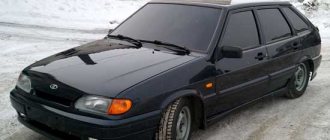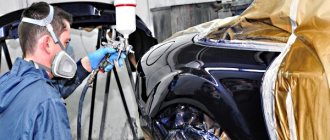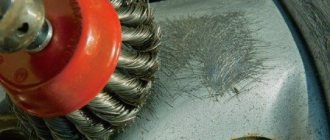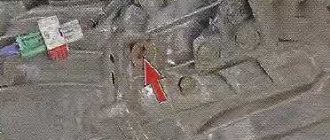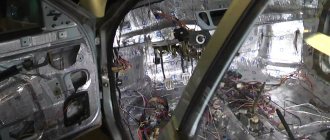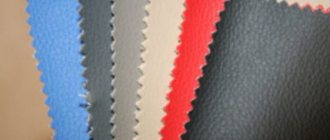Headlights are one of the most vulnerable elements of a car. Their damage affects not only their appearance, but also their driving safety. Small stones, sand, and tree branches gradually lead to the formation of small chips and scratches on the surface of the headlight. Because of this, the light begins to scatter and visibility deteriorates.
If this has already happened, you can do polishing, but this is an expensive service that you don’t want to resort to constantly. There is a cheaper way - take care of the safety of the lighting elements in advance and make a reservation for the headlights. We'll tell you more about it and give step-by-step instructions.
Which film to choose for headlight reservations
All protective films that cover lighting fixtures are made of polyurethane or vinyl.
Vinyl films are cheaper than polyurethane films. In addition, such products are available in a more diverse color palette. They have a thin structure, so they are easier to work with at home.
For headlights with a curved surface, it is better to choose polyurethane. For such optics, armoring headlights with polyurethane film will be easier than applying vinyl. In addition, polyurethane better protects the lighting fixture from mechanical damage.
Vinyl film from the Canadian brand Ricochet is highly elastic and is suitable even for working with headlights of complex configurations. One of the best polyurethane materials is the American Venture Shield film, which is very easy to apply to any surface.
If you choose material from lesser-known manufacturers, check it before purchasing. Low-quality film emits a strong smell of glue, and it breaks when stretched.
Regardless of the material, headlight armoring with protective film follows the same pattern.
Tools to help you work
To protect car thresholds with protective film, we will need:
- Protective film for armor (at least 200 microns thick);
- Soap solution (it is best to use Fairy or baby shampoo, without alkali);
- Spray bottle;
- White spirit (for degreasing the surface);
- A powerful hair dryer (preferably a construction hair dryer);
- Sharp knife;
- Scissors;
- Soft squeegee.
Headlight reservation: pros and cons
Advantages:
- Extends the life of the headlight as it protects it from minor damage.
- Even in the event of a strong impact, the glass does not fall onto the road, but remains inside the film.
- Various color options allow you to personalize your vehicle design.
Flaws:
- Deterioration of light transmittance.
At the initial stage, light transmittance is reduced only if you use low quality film. Of course, over time, scratches will appear on any film and it will need to be replaced, but this will not happen immediately. In addition, polyurethane has the ability to recover from minor damage, so it lasts longer than vinyl.
- Appearance of yellowness.
It is believed that over time, transparent films, especially polyurethane films, begin to yellow. This can only happen with low-quality material that changes its properties under the influence of xenon lamps and ultraviolet radiation.
Why use protective film for car sills
The body is the most expensive part of the car, and when selling a car on the secondary market, the buyer first of all looks at the safety of the body. If you regularly expose the car threshold to physical impact, touching it with shoes, especially women's heels, over time the top layer of paint on it will wear down to metal. This is fraught with the emergence of a large number of problems, including the formation of corrosion on the metal and the spread of rust to other areas of the body.
The outer part suffers no less than the inner part of the thresholds. It is constantly exposed to physical impacts from various particles flying off the road surface when the car moves - sand, gravel, stones, etc. External sills are scratched and may cause paint chips.
Please note: Many drivers refuse the idea of repainting the sills because they understand that they will be different in color from the rest of the car body. But this is not so, the modern method of computer paint selection allows you to analyze and select paint that will exactly match the color already applied to the body
To prevent the above defects with thresholds from occurring, you can use a protective film.
Reserving headlights with film: step-by-step instructions
Step 1: Preparing the Headlights
It is advisable to remove the headlights. If dismantling is too difficult, the reservation can be done directly on the vehicle. The headlights must be washed thoroughly with detergent and dried. If they are old and there are microcracks on the surface, you need to polish them first. To do this, it is better to use the services of a car repair shop, but you can polish the headlight yourself using abrasive paper or polishing paste.
Step 2: Preparing the Film
Using scissors, a utility knife or a thin blade, make a blank from the film. Ideally, you need to measure it so that it covers the entire surface of the headlight and protrudes 1.5-2 cm on each side.
Step 3: working with the form
The headlight has a convex surface, so you need to not just glue it, but pre-stretch the film. To do this, you need to place it on the glass and heat it with a hairdryer - then it will take the desired shape. After this, the entire surface must be degreased with alcohol.
Step 4: Fixing the Film
There is a protective layer above the film, which must be separated from the edge by 3-4 cm and at this point the film must be glued to the glass. Next, heat the glued area with a hairdryer and level the surface with a rubber spatula. Gradually glue the film in 3-4 cm strips using a hairdryer and spatula.
Step 5: Finishing Touches
Carefully cut off the protruding parts of the film, leaving 3-5 mm around the entire perimeter. A thin blade is ideal for cutting. Next, heat the edge with a hairdryer and bend it using a thin object. If you removed the headlight, reinstall it.
Preliminary preparation
The mistake of most motorists who decide to independently armor the thresholds of their car with a special film is to ignore the preparatory stage of this work.
There are even those who simply brush off a layer of dust from the threshold and immediately begin gluing the material. As a result, approximately the same subsequent picture occurs. After a while, the film begins to peel off, air bubbles form under it, it quickly breaks and only spoils the appearance of the car.
In order to correctly apply a previously purchased protective film to the thresholds of your own car, you must first complete the required preparation. It consists of several stages:
- If the car has been in service for more than one year, the paintwork could become damaged and begin to peel off. It is better to immediately protect these places, paint them and varnish them.
- If the configuration of the thresholds is quite complex, some dismantling may be required to get to hard-to-reach places.
- The thresholds are washed and dried very carefully. It is advisable to blow out all the cracks and gaps with compressed air so that there is no moisture under the film.
- After drying is complete, use any product with degreasing properties. Make sure it will not damage the paintwork.
- The thresholds will probably have places where the film is bent. It is recommended to treat these areas with a primer.
It is recommended to work with films indoors. If it is a dusty garage, it is better to carry out a wet cleaning first so that the dust settles and does not fall on the body elements during the film application process.
It is not necessary to apply armor film at negative ambient temperatures. Each manufacturer has its own recommendations regarding the optimal temperature conditions for working with the material.
Important nuances
- After you have booked your car headlights, you need to avoid getting the film wet for two days. Do not wash your car or leave it outside in rainy weather.
- The film will deteriorate faster if you wash the surface with powder or abrasive agents, so use soap for washing. Also, do not direct the jet of a high-pressure apparatus at the headlights.
- Global manufacturers promise that the material will last about 5–7 years, but in Russian road conditions this period is reduced to 3–4 years.
To correctly make headlight film reservations with your own hands, we recommend that you first watch training videos.
How is threshold gluing done?
The procedure for applying anti-gravel film to the surface of car sills is as follows:
- The surface is thoroughly cleaned. For this purpose, special auto chemicals are used, which allow you to remove even the most difficult stubborn dirt such as bitumen stains.
- A pattern is prepared exactly according to the shape of the thresholds. In order for the material to reliably protect the entire part, an allowance is made so that the film extends under the surface of the part.
- The film is applied to the surface in accordance with the technology recommended by the manufacturer. It fits the surface very tightly and precisely, repeating the geometry of the body and ensuring complete transparency.
- The material takes some time to gain strength, so for a week after pasting it is necessary to avoid washing the car and treat the surface more carefully. A week later, all restrictions are lifted, and the defense fully does its job.
Our company employs craftsmen with at least 10 years of experience who know all the intricacies and strictly follow the technology. It is possible to carry out work in your presence so that you can make sure that all work is carried out to a high standard.
Recommendations for choosing armor film
The film manufacturer must be known in the automotive market. He is required to have certificates confirming the quality of his products. We recommend asking the seller about the availability of such documents so as not to buy a fake.
Windshield armor film should only be used for its intended purpose. Before applying it, a number of preparatory works are required. They cannot be ignored, otherwise the coating will not perform its protective functions and will quickly deteriorate. We advise you not to save money, because materials that are too cheap are likely to be of poor quality.
Beware of fakes
We recommend purchasing armored film only from official representatives in automotive stores. Check the certificates of conformity, expiration date and storage rules for the material.
On the market and online classifieds sites, counterfeits are often sold, which are passed off as genuine products from well-known manufacturers. We advise you not to take such goods “from hand to hand” through friends. After all, you run the risk of covering your car with a low-quality coating that will not protect its body from damage, but rather ruin it.
Types of film coatings
There are mainly two types of protective films on the market: vinyl and polyurethane.
It will be more expensive to wrap your car with the latest wrap because the material is more expensive than regular vinyl. Reserving a car with film is an opportunity to protect the body cover from minor scratches, chips and other small “surprises” that may happen on the road. Vinyl protective film is an inexpensive option to protect your car from scratches. Its composition is similar to ordinary plastic. To attach it to a car, the material must be heated. After cooling, the vinyl fabric shrinks in size and completely adheres to the metal parts of the car.
Polyurethane film is a modern and expensive option for creating an anti-gravel coating on a car body. The material resembles rubber and easily fits the car body, so it does not need to be heated. Despite the higher cost, this type of film has become widely popular among car owners.
Features of vinyl and polyurethane films
Vinyl protective film is a thin material about 100 microns thick. Armoring the car with this layer will well protect the car body from small chips, scratches or improper washing. The material has no less disadvantages than advantages. First of all, the material does not tolerate frost well, hardens, and can peel off from the body. This means you will have to wrap the car again. In addition, vinyl does not withstand the effects of chemicals that are used during icy conditions, and is also subject to fading in bright sunshine. One of the pleasant advantages of protective film is a wide range of colors, which makes it possible to cover your car in one of the desired colors.
Article on the topic: Full and partial automatic transmission oil change - which is better? Urethane protective film is a more durable and thicker coating option with a thickness of up to 300 microns. The material protects the car body well from large scratches and chips. Anti-gravel film of this type is transparent. For protection, it is not at all necessary to tape the car completely. It is enough to place the material on the most vulnerable places of the car. Polyurethane transmits ultraviolet rays well. Thus, the glued and non-glued parts of the car will look the same. Armoring a car with this type of material is an expensive proposition. If a regular vinyl protective film on the market costs less than 1 thousand rubles per meter, then urethane costs an average of 3 thousand rubles per meter of coverage.
Car armoring with film
Almost all car dealerships that offer car sizing services use a soap solution for coating. For example, water with the addition of alkaline-free shampoo or dishwashing liquid. Some of the specialists cover the car with material using water, without adding any substances. But it is still worth using a soap mixture, since it prevents the coating from sticking, and it can also be corrected if necessary.
Is it possible to tape a car yourself? Yes. The main requirements for performing this task are to maintain a constant temperature at 20–22 degrees and avoid drafts. The car body must be clean, free from dirt and dust particles.
It is very important that there is no dust on the car body, as well as in the room. When the protective coating is peeled off from the material, static electricity is generated, which quickly attracts dust, so wrapping a car will not give the desired decorative effect. A special feature of applying a protective polyurethane film is that the car must be dried for 10-12 hours after pasting with anti-gravel material. After the coating on the car body has dried, you can begin to adjust some parts and eliminate any shortcomings that have arisen.
Remember that the film should only be applied to a car with intact paintwork. The body of a car, even with low mileage, may have scratches or small chips. This will cause the film to look worse.
Main characteristics of armored car film for vehicle body
The difference between armored and other protective films is in the principle of operation, which consists in distributing the impact energy over a large area in different directions. Energy is not concentrated in one place, and such dispersion is life-saving for the hood, windows, and other parts of the car protected by armored film.
Interesting! Reserving the paintwork protects it from cracking and tearing, even if a dent appears as a result of an impact. The price of armored film is significantly less than the cost of repainting a body part.
By restoring the deformed area using available modern technologies, you will not need to repaint the car. Most often, armor film for a car is made of high-strength polyurethane. This material has excellent characteristics that allow it to withstand various factors during operation.
| Factor | Reaction |
| Various mechanical influences | Armoring of the body and windows will protect your car from damage as a result of impacts from stones, branches, and small objects |
| Infrared and ultraviolet radiation | The film does not transmit UV and IR radiation, completely neutralizing the effects of high temperature. Thus, glass armor also protects the car interior from fading. |
| Formation and development of corrosion | Body armor protects the paintwork from penetration of moisture, which, if there are scratches on it, causes rust. Armor film has excellent hydrophobic properties |
| Exposure to an aggressive environment | Various reagents that are actively used by utility workers in the winter do not have a negative effect on polyurethane |
Expert opinion
Ilya Vyacheslavovich
Consultant for body repair at krasymavto.ru
Ask a Question
Armor films come in different thicknesses. The thicker the material, the stronger and more reliable it is, but at the same time it is less elastic, which makes it difficult to mount it on curved elements of a car and pasting glass.
Competitive advantages of Autosecurity detailing center
High quality materials
In our work, we use only materials from leading manufacturers, proven by many years of practice: 200-micron anti-gravel polyurethane film SunTek PPF (USA) and Stek DynoShield, 100-micron protective PVC film KPMF (Great Britain), 150-micron transparent hybrid (PVC with the addition of urethane ) Ricochet film (Canada). We offer two types of protective films: matte transparent and transparent with a glossy effect.
Qualified specialists
Our craftsmen have extensive practical experience and an impeccable reputation. All work is carried out strictly according to the manufacturer’s technology using special tools and high-quality consumables, which guarantees many years of operation of the coating. To avoid damage to the film and misunderstandings during car washing, our specialists turn all corners and edges inward, and do not cut around the perimeter, as at most stations.
Loyal pricing policy
We offer attractive loyalty programs, bonuses and promotions for our regular customers. In addition, members of partner car clubs can also count on a 12% discount, and any website visitor can receive a 7% discount coupon.


